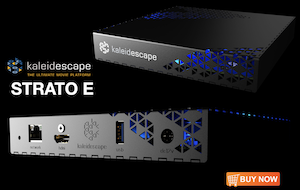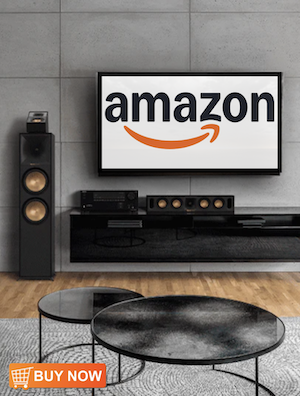- Manufacturer & Model
- Scenic Labs LX1 Bias Lighting CRI 95 6500K Simulate D65 White Bias Lights, MagicHome Wi-Fi Dimmer
- MSRP
- $15-$50
- Link
- https://www.biaslighting.com/products/lx1-bias-lighting-cri-95-6500k-simulated-d65-white-bias-lights
- Highlights
- Affordablity bias lighting with quality assurance built-in, 6500K light with a CRI 95, compatible with three different controls, immediate visual impact.
- Summary
- Scenic Labs LX1 Bias Lighting kit gives enthusiasts access to highly affordable, easy to install TV bias lighting. Adhering to high standards, the kit delivers reference-quality that improves black levels and contrast, and makes colors appear more vibrant. Installation is simple and the kit integrates with one of three controller units. Results speak for themselves, easing eye strain during low ambient light viewing sessions and improving perceptual qualities on the screen.
Whether you own the latest and greatest 8K OLED or an aging 720p plasma, there are several straightforward ways to coax better performance from your screen. Some are free tweaks you can and should make within your TV's menu system, while others are going to tax your wallet. Luckily, the subject of today's review – Scenic Labs' LX1 Bias Lighting kit – won't break the bank. For a mere $15-$50 (depending on length), you can boost your TV's performance with better perceived color, contrast, and black levels, while simultaneously giving your eyes and brain permission to relax during low ambient light viewing sessions.
Ocular Trickery?
Before we dissect the LX1 Bias Lighting kit, take a moment and study the image above. You'll note its background is shaded from dark to light, but what's going on with the grey bar in the middle? Is it shaded, too? Your better sensibilities likely know the bar is one solid color, but I guarantee your eyes disagree.
What you're seeing is an optical illusion, the same optical illusion that happens when a bias light illuminates a reference surface behind an object. In the case of our example, your eyes view grey as being darker when framed by a lighter reference background and lighter as that background darkens. The same thing happens when we add bias lighting to the backside of a TV. Blacks look blacker, contrast improves, and color – yes, color – looks more vibrant.
The President and Founder of Scenic Labs, Jason Rosenfeld, says impacts extend a bit deeper than this classic example. "Bias lights enhance perceived contrast," explains Rosenfeld. "So, this boosts highlights as well as shadows." To demonstrate, Rosenfeld provided another visual prop, adding, "The simulated 'dim surround' around the white square on the left will enhance the perceived brightness of the brightest part of the image on the left."
Outside of tricking your eyes, bias lighting also reduces eye strain and headaches associated with dark room TV viewing. When we kill the lights to set the mood or eliminate on-screen light reflections, our eyes are subjected to a large bright object that's constantly changing in intensity. The difference in luminance between the screen and the room is intensified by rapid shifts in brightness, all of which force our pupils to dilate constantly.
The result? You guessed it: eye fatigue.
Illuminating the wall behind a television raises the amount of ambient light in a room, which lightens the load on our eyes.
Don't Use Any Old Light
Now that we've established some principles of bias lighting, you’re probably wondering if a lamp placed behind your TV will do the trick.
Unfortunately, the answer is no.
The source of a bias light needs to be hidden from direct view, dispersing light equally around the edges of a TV for an even "halo effect.” Also, The Society of Motion Picture and Television Engineers (SMPTE) says bias lighting should approximate 10% of the maximum brightness of peak white levels on any given display. That means it needs to be dimmable, which is particularly noteworthy given the high levels of brightness modern LED strips can generate.
Color temperature is also a key component. Light straying too far from reference white (6500K) can cause a perceptual tug of war. If a light is too warm (trending toward yellow, orange, or red), images on a TV will take on a bluish appearance. If it's too crisp and loaded with blues, images will push toward a reddish appearance. And, if a light has a green or magenta tint, this will impact the perceived tint of the picture.
Reference white is a spectrum of light identified as D65, a color point that anchors professional TV calibrations and is the most accurate representation of natural daylight. This notion of natural daylight extends to another measurable component of lighting: the Color Rendering Index (CRI). When natural daylight strikes an object, our eyes see reflected light. For example, if you hold a ripe banana in natural sunlight, the banana absorbs every color within the light's spectrum but yellow. If you were to hold the same banana under a low-quality LED lamp with poor color rendering capabilities, it might look more orange than yellow!
CRI indicates the accuracy of a light's spectral composition and its ability to reveal true-to-life colors. It's measured using a 100 point scale, with values of 90 or higher considered to be excellent. That said, Rosenfeld says that CRI is a "somewhat outmoded measurement, noting that consumers should also pay attention to Television Light Consistency Index (TLCI) and TM30-15 values. "You can still go off of CRI," says Rosenfeld. "But it omits crucial values such as R9 (bold red) and R12 (bold blue). LX1 and MediaLight both perform even better than the competition when you factor in these values."
Meet the LX1 Bias Lighting Kit
LX1 Bias Lighting is a division of Scenic Labs, a company that also publishes the Spears & Munsil HD Benchmark and UHD Benchmark set-up discs and manufactures The MediaLight Bias Lighting System. LX1 is technically an affordable MediaLight alternative, but Scenic Labs says that affordability doesn't mean that quality and quality control have been sacrificed.
LX1 kits can be purchased in six different sizes, ranging from Extra Small (1 meter in length) to Extra Large (6 meters), and can be cut to fit your television's exact dimensions. Each kit is also compatible with three different dimming options (button dimmer, infrared remote dimmer, and MagicHome Wi-Fi Dimmer/App) and plug-in directly to a USB 2.0 or 3.0 port on the back of a TV.
Scenic Labs says the LXI Bias Lighting kit delivers simulated D65 white with a CRI of 95. It also carries an ISF lab certification of 6500K – a reassuring stamp of quality – and uses black LED strips as opposed to white (white strips can taint a light's coloring, especially as they age and yellow). Overall light output caps at approximately 400 lumens, which is significantly brighter than anything most applications will require.
The entire kit carries a 2 Year Warranty covering just about every possible claim scenario.
Unboxing
Scenic Labs sent me an Extra Large 5 meter (16.4 ft) LX1 Bias Lighting kit with a MagicHome Wi-Fi Dimmer for a 65" LG B6 OLED 4K TV. The kit and dimmer are sold separately, retailing for a combined $53.90.
Both components arrived in a FedEx envelope. The MagicHome Wi-Fi Dimmer, a block of double-sided tape, and an instruction slip were sealed in a see-through static-free bag, while the LX1 kit was packaged in a retail-ready resealable foil bag.
The LED strip was neatly wound within a movie reel style holder, accompanied by a 15" USB power cable and a small introductory leaflet. The bulk of installation instructions and troubleshooting tips can be found online at LX1.com/install and LX1.com/troubleshoot.
Installation
If you've handled a standard flexible LED light strip, then you have a general idea of what to expect with the kit. One side of the LX1 strip contains LED diodes, the other side is sticky, and one end terminates to heat-shrink tubing and a power cord. Overall, everything appeared to be of high quality.
Scenic Labs says the strip is best installed 2" from the edge of a TV’s frame, which I easily achieved without removing my display from the wall. After cleaning my TV's rear housing with rubbing alcohol, I used a ladder (and some patience) and had the entire kit installed in about ten minutes. Downloading the MagicHome app and integrating the Wi-Fi dongle with my network took another five minutes, which clocked the total amount of installation time in the 15- to 20-minute range.
The light strip's sticky surface provided plenty of grip but was forgiving enough that slight errors during installation were easily reversed and corrected. I was left with roughly one foot of excess lighting, which was easily clipped by scissors. The kit's online instructions provided all of the guidance needed for a smooth installation experience, and the kit has remained firmly affixed to my LG OLED for more than a month.
It just so happens that my living room's walls are a light neutral gray (Behr, 790E-2 Gentle Rain), providing an excellent backdrop for illumination. With the TV on and room lights off, I used the MagicHome app to dial back the LX1's output to roughly 10% of my TV's peak brightness. That exercise led to a setting of 45% brightness within the app.
The resulting glow of light was a welcomed addition to an otherwise darkened room. During the duration of this review, the light kit performed flawlessly, never dimming or flickering during use.
Impact
My OLED's black frame immediately popped to life during the first seconds of use, establishing itself as present and jet black. That alone was pleasing to the eye but not nearly as pleasing as the vibrant, easy-to-view image that graced my screen.
As described earlier in the review, black levels and contrast were noticeably improved when the LX1 Bias Light was engaged. It's tough, if not impossible, to capture this improvement with a camera (at least with my middling photographic skills), but I tried to illustrate visible differences during a recent World Series game. Lean in and let your eyes inspect the dark area directly over the manager's hat and you can see the difference in black levels. In person, the difference is striking, so much so that my wife, who possesses an ironic disinterest in AV tech, immediately applauded the improvements delivered by the LX1 kit.
The LX1 also magically made colors appear to be more vibrant – there's no denying it's ability to alter perception.
The impact of the kit on dark room viewing was notable. Gone was time spent adjusting ceiling lights to "just the right level" (they were left off) and annoying screen reflections were completely eliminated. I was left with a pleasing viewing environment. Eye fatigue and watching TV in low ambient light is something I've experienced in the past, and the LX1's steady glow made changes from dark scenes to images loaded with bright whites easy to handle.
As a bonus, the light kit turned on and off with my TV, and the MagicHome Wi-Fi controller remembered my last brightness setting. The app also allows for five brightness presets and integration with 3rd Party Services such as Alexa and Google Assistant. In other words, you can practically set it and forget it. Not all TV brands sever power to USB ports at power down, so your mileage may vary. Scenic Labs cites Sony Bravia TVs as one brand that won't cut power to the light kit when the TV is turned off – you'll need to turn the lights off separately.
Conclusion
Scenic Labs' LX1 Bias Lighting kit checks all of the right boxes.
Affordability? Check
Variety of sizes? Check
Fast shipping? Check
Quality construction and light output? Appears to be a check
Ease of installation and use? Check
Performance impact? Double-check
Reasonable warranty? That gets a check, too
For a small investment, you can give your TV viewing experience an impressive boost in performance. Blacks appear blacker, contrast gets an uptick, and colors look delicious and vibrant; all wins across the board. I'm so impressed that I plan to integrate LX1 kits with two other flat panels in my home – the impact of controlled bias lighting is that notable. Do yourself a favor and pick one up – it’s a no-brainer buy.
Scenic Labs, post-review, was kind enough to extend AV NIRVANA an affiliate link. If you're considering purchasing a kit and would like support our community, please purchase by clicking here.
Editor's Note: Recently, the Founder and President of Scenic Labs,LLC, Jason Rosefeld, joined AV NIRVANA for a live chat. He led us DEEP into the jungle of Bias Lighting with lots of rich detail about how and why it works, while also showing us measurable proof that not all bias lighting is the same. If you want to learn a lot about visual science and the science behind light, kick back and enjoy!
LX1 Bias Lighting CRI 95 6500K Simulated D65 White Bias Lights Specifications
•6500K (ISF-certified for accuracy)
•Color rendering index (CRI) 95
•Spectro Report (.PDF)
•Connects via USB 3.0 to your TV (shorter lengths from 1m-4m work with USB 2.0)
•USB and DC connectors for limitless connectivity and controller options
•Includes 15 inches of power cable. (If your USB port is further away from the edge, you may need an extension cable. We offer an approved 0.5m extension for $7.95. One is also included at no charge with our MediaLight Mk2 Flex)
•Pair the LX1 with a dimmer (sold separately), to create a complete bias lighting system
•2 Year Warranty
Last edited:









